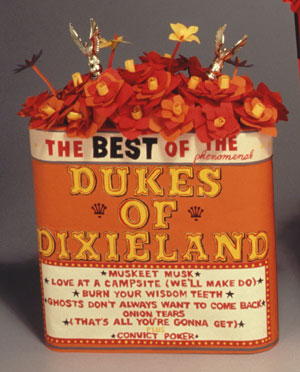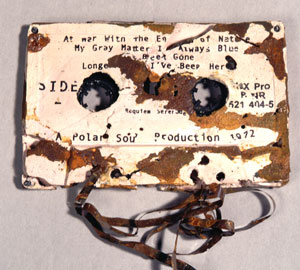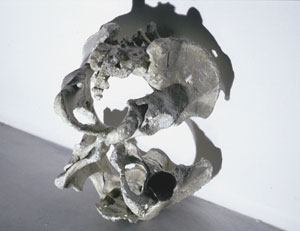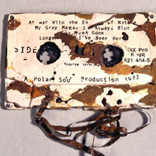I saw Matthew Barney’s Guggenheim survey before I was able to take in the "A" and "B" sides of Dario Robleto’s current show at Inman Gallery.
Now I can’t help but compare them. Both artists are born storytellers, natural imaginers of character and place, and both delve into highly personalized mythologies. Barney has reinjected psychosexual attenuation into the unblinking consumerism that dominates the contemporary artworld, using Vaseline as his symbolic lubricant. Robleto uses ground vinyl as his magic dust, turning song sampling and musical relics into a lever for accessing the specific histories of pop subcultures. Both artists play trompe l’oeil games with perception and the nature of reality in order to gain access to the viewer’s head, heart, or other organs. But most of Barney’s large-scale sculptural tableaux seem curiously denatured in person, exhausted objects that, having performed brilliantly in the service of a film, turn curiously flat in person. Robleto’s finely crafted, modestly scaled objects, by contrast, resonate with the specificity of historical and personal complexity.

Dario Robleto, Roses In The Hospital, 2002... paper, colored pencil, metal & plastic trophy parts, foamcore, glue... variable dimensions
Robleto’s current project, on which he has been working for nearly two years, is also his first embrace of the cinematic approach that is Barney’s strong suit. Ricocheting through Roses in the Hospital/Men Are the New Women are competing notions of perpetuity and transition. This conundrum is given form by Robleto’s invention of a central character, a young, patriotic American soldier plucked out of time in order to visit battlefields of each of this country’s wars. To create the sculptures that illustrate episodes in his character’s story, Robleto created storyboards and background stories that he used almost as a forensic scientist would use forceps and calipers to demarcate the features of a missing person. This technique animates and unifies individual objects, making them seem more accessible and encompassing than some of Robleto’s earlier efforts.
Dust to dust, goes the Christian burial prayer, and in Roses in the Hospital Robleto’s unnamed character suffers a number of hurts and indignities that grind him down. Finally, like Prokofiev’s Lieutenant Kije (another fictional soldier in a musical setting who was created to solve a dilemma), he disappears. Literally turning to dust after experiencing the battle to end all battles, Robleto’s character becomes the ubiquitous "ghost in the machine." Robleto allows only one artifact to survive his demise, a battered, nonfunctional audio cassette containing the soundtrack of the final battle. Meticulously constructed out of human bone dust, tritinite, and an actual (although unhearable) soundtrack that imagines the unimagineable, At War With the Entropy of Nature/Ghosts don’t Always Want to Come Back is the climactic lodestone of side A. Robleto sets about rebuilding his character in Men are the New Women, beginning by inverting God’s second act of human creation (the animation of Eve out of Adam’s rib). The starting point and centerpiece of side B is an exquisitely crafted vitrine containing a male ribcage bone cast from the dust of a female ribcage bone. Theatrically spotlit, it embodies the process of rebuilding and reconciling what is "bred in the bone" that gives Men Are the New Women what Robleto calls a "window of hope."
In Robleto’s form-follows-function approach duplication equals verification, and since bones figure so prominently in his story, human dust has largely replaced ground vinyl as his material of choice. Cast or carved, it is partnered with historical artifacts from past American wars as well as materials with overtones that range from the funereal (mortician’s makeup powder) to the apocalyptic (trinitite). Robleto’s chosen materials are especially poignant since so much of his work contrasts the specificity of material existence and the inability to understand it without letting go. There is a votive quality to much of this work, a fetishization that extends far beyond the needs of object construction. It activates and humanizes the dusty perpetuity that his exacting object replications strive to depict. We our made of the past, Robleto seems to be suggesting, and this is a heritage we ignore at our peril.
Titles like Not All Dead Rather Be Living and The Abstractness of a Blown Off Limb, (from Roses in the Hospital) or Our Sin Was in Our Hips and Skeleton Wine (from Men are the New Women) reinforce an elegiac mood. This can be traced not only to the often-barbarous historical associations contained within each piece, but also with the way they are reframed in terms of recent history and popular culture. "Reading" Robleto’s sculpture produces a cascade of reverberating associations by symbolically linking the mortal and emotional pain of "combatants" from separate centuries. For example, in Not All Dead Rather Be Living (Roses in the Hospital) Robleto recasts Civil War "pain bullets" (given to Civil War soldiers to bite on during amputating surgery) out of the melted vinyl of seven pop musicians. Bob Marley, Marvin Gaye, Kurt Cobain, Sam Cooke, Del Shannon, and John Lennon each wrote songs about hurting or healing, and all experienced deaths that were violent, painful, and mostly gunshot-inflicted.
Our Sin Was in Our Hips (Men Are the New Women) is perhaps the closest Robleto has come to self-portraiture. Mixing bone and vinyl dust, he cast a female pelvis from his mother’s collection of rock and roll singles from the 50s and 60s, and a male pelvis from his father’s collection of rock and roll LP albums. These faux bones are positioned against the wall, but on the floor, as if conjoined in a coital embrace. This weird amalgam of factual past — his parent’s creative passion, powered by hip-swinging bump-and-grinders like Chuck Berry and Elvis Presley — led to Robleto’s own creation. He in turn reveres this past even as he fictionalizes his parent’s passion into a rehabilitative, future tense metaphor that will infuse his vanished character with the spirit of a time "when music was a moral decision."
Impending war is a constant topic these days, and even though Robleto began imagining his soldier before 9/11/01, this show is much more aggressively confrontational than Robleto’s earlier bodies of work, which tended to make references within the confines of an in-group rather than across aesthetic or political boundaries. The artworld can seem like a proverbial "hill of beans" compared to the traumas and tragedies of war, but Robleto’s fusion of deconstruction and reconstruction is also a direct challenge to the artworld’s current inward-looking stasis, which I saw embodied in all its glory in Matthew Barney’s aesthetic. Intently confusing new and old and reversing our expectations of form and substance, Robleto seems to be seeking a way of reconciling our recent, deconstructive past with the more constructive aspects of modernist thought.
All images appear courtesy the artist and Inman Gallery.
Christopher French is an artist and writer living in Houston.






